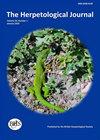How does captivity affect skin colour reflectance of golden mantella frogs?
IF 1.1
4区 生物学
Q3 ZOOLOGY
引用次数: 2
Abstract
Coloration is an important trait for social communication in amphibians, being used in intra- and intersexual signalling to express information about individual body condition and health state, amongst other things. The striking colour pattern exhibited by some anuran species are also used in “aposematic” signals to advertise unpalatability to predators. The aim of this study was to investigate how the captive environment affects the colour of golden mantella frogs by comparing captive reared frogs with wild conspecifics. A USB-2000 portable diode-array spectrometer and a xenon strobe light source were used to perform spectrophotometric measurements on captive and wild populations. Hue, chroma and brightness of skin colour were analysed as well as body condition using the scaled mass index. Analyses showed variation among populations, but significant differences were only found between captive and wild populations. Generalised linear mixed models were used to evaluate the effects of body condition on colour variation and showed that animals with lower body condition from one captive population had significantly different coloration than their wild counterparts. Importantly, one captive population was not greatly different in coloration from their wild counterparts – demonstrating that this problem is not inevitable in captivity. These results can have important implications for reintroduction programmes.圈养是如何影响金曼特拉蛙的肤色反射率的?
颜色是两栖动物社会交流的一个重要特征,用于性内和性间信号传递,以表达有关个体身体状况和健康状态的信息等。一些无尾类物种表现出的引人注目的颜色模式也被用于向捕食者宣传不愉快的“信号”。本研究的目的是通过比较圈养青蛙和野生同种青蛙,研究圈养环境如何影响金曼特拉蛙的颜色。USB-2000便携式二极管阵列光谱仪和氙频闪灯光源用于对圈养和野生种群进行分光光度测量。使用标度质量指数分析肤色的色调、色度和亮度以及身体状况。分析显示,种群之间存在差异,但只有圈养种群和野生种群之间存在显著差异。使用广义线性混合模型来评估身体状况对颜色变化的影响,并表明一个圈养种群中身体状况较低的动物与野生动物的颜色明显不同。重要的是,一个圈养种群在颜色上与野生种群没有太大区别——这表明这个问题在圈养中并非不可避免。这些结果可能对重新引入计划产生重要影响。
本文章由计算机程序翻译,如有差异,请以英文原文为准。
求助全文
约1分钟内获得全文
求助全文
来源期刊

Herpetological Journal
生物-动物学
CiteScore
2.40
自引率
10.00%
发文量
25
审稿时长
>12 weeks
期刊介绍:
The Herpetological Journal is the Society''s prestigious quarterly scientific journal.
 求助内容:
求助内容: 应助结果提醒方式:
应助结果提醒方式:


